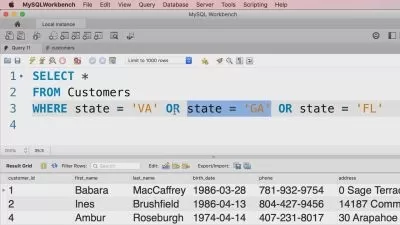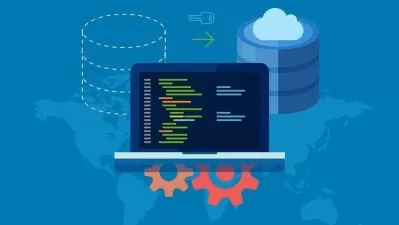1Z0-171: Oracle Database 23ai SQL Associate
Phillip Burton
14:56:33
Description
The SELECT statement, functions and more. Oracle Database 19c, 21c, 23c, 23ai using Oracle SQL Developer. 1Z0-171 exam.
What You'll Learn?
- Relational Database Concepts
- Retrieving Data using the SQL SELECT Statement and Restricting and Sorting Data
- Using Functions
- Displaying Data from Multiple Tables, including using SET operators
- Using Subqueries to Solve Queries
- Managing Indexes Synonyms and Sequences
- Manage tables and their relationships using DDL and DML statements
- Control User Access
- Managing Objects with Data Dictionary Views and Data in Different Time Zones
Who is this for?
What You Need to Know?
More details
DescriptionThis course is the foundation for the Oracle Database SQLÂ 1Z0-171 certification. It covers the SELECTÂ statement in detail, with additional requirements for controlling user access.
We'll install for free Oracle Express Edition and Oracle SQLÂ Developer. Then we'll take a look at the 6 principal clauses of the SELECTÂ statement:Â SELECT, FROM, WHERE, GROUP BY, HAVING and ORDER BY.
Then we'll start creating tables, but find that we can't get very far without understanding data types. We'll then look at string, date and number types and functions, together with looking at functions converting between them.
We'll revisit the SELECT statement and go into more detail. We'll create tables and JOIN them together. Once you have finished this session, you should be secure in your knowledge of the 6 principal clauses of the SELECT statement, the most important part of Oracle SQL.
We'll then looking for missing data, and find out how to delete and update data. We'll look at the difference between implicit and explicit transactions, and various constraints, including primary and foreign keys.
We'll start off by saving our queries in views. Then we'll combine tables, not by adding additional columns using JOINS, but adding additional rows such Oracle SQLÂ set operators such as UNION, INTERSECT and MERGE.
We'll add totals to our SELECT queries. We'll then look at subqueries, and how you can add them into the FROM, SELECT and WHEREÂ clauses, and also into the WITH clause. We'll also look at Oracle SQLÂ self-joins, which are useful when you have hierarchies.
Finally, TIMEÂ ZONE and INTERVAL data types and functions. We'll then have a look at SEQUENCEs and INDEXes, together with how these are shown in the Data Dictionary. We'll then create new users, and assign privileges and roles to them, and we'll finish with the last few requirements for the exam.
No prior knowledge is required - we'll even install Oracle Database and Oracle SQL Developer on your computer for free!
Once finished, you will know what how to manipulate numbers, strings and dates, and create database and tables, create tables, insert data and create analyses, and have an appreciation of how they can all be used in Oracle SQL.
Who this course is for:
- This SQL course is meant for you, if you have not used Oracle SQL Database much (or at all), and want to learn SQL.
- This course is also for you if you want a refresher on SQL. However, no prior Oracle SQL Database knowledge is required.
This course is the foundation for the Oracle Database SQLÂ 1Z0-171 certification. It covers the SELECTÂ statement in detail, with additional requirements for controlling user access.
We'll install for free Oracle Express Edition and Oracle SQLÂ Developer. Then we'll take a look at the 6 principal clauses of the SELECTÂ statement:Â SELECT, FROM, WHERE, GROUP BY, HAVING and ORDER BY.
Then we'll start creating tables, but find that we can't get very far without understanding data types. We'll then look at string, date and number types and functions, together with looking at functions converting between them.
We'll revisit the SELECT statement and go into more detail. We'll create tables and JOIN them together. Once you have finished this session, you should be secure in your knowledge of the 6 principal clauses of the SELECT statement, the most important part of Oracle SQL.
We'll then looking for missing data, and find out how to delete and update data. We'll look at the difference between implicit and explicit transactions, and various constraints, including primary and foreign keys.
We'll start off by saving our queries in views. Then we'll combine tables, not by adding additional columns using JOINS, but adding additional rows such Oracle SQLÂ set operators such as UNION, INTERSECT and MERGE.
We'll add totals to our SELECT queries. We'll then look at subqueries, and how you can add them into the FROM, SELECT and WHEREÂ clauses, and also into the WITH clause. We'll also look at Oracle SQLÂ self-joins, which are useful when you have hierarchies.
Finally, TIMEÂ ZONE and INTERVAL data types and functions. We'll then have a look at SEQUENCEs and INDEXes, together with how these are shown in the Data Dictionary. We'll then create new users, and assign privileges and roles to them, and we'll finish with the last few requirements for the exam.
No prior knowledge is required - we'll even install Oracle Database and Oracle SQL Developer on your computer for free!
Once finished, you will know what how to manipulate numbers, strings and dates, and create database and tables, create tables, insert data and create analyses, and have an appreciation of how they can all be used in Oracle SQL.
Who this course is for:
- This SQL course is meant for you, if you have not used Oracle SQL Database much (or at all), and want to learn SQL.
- This course is also for you if you want a refresher on SQL. However, no prior Oracle SQL Database knowledge is required.
User Reviews
Rating
Phillip Burton
Instructor's Courses
Udemy
View courses Udemy- language english
- Training sessions 153
- duration 14:56:33
- Release Date 2024/11/18











